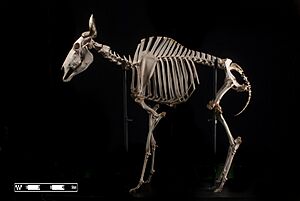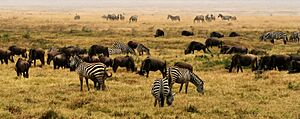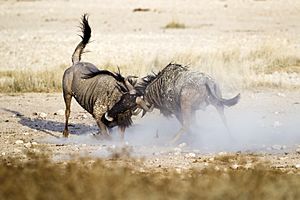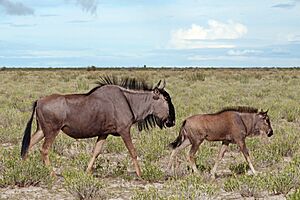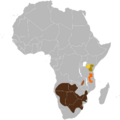Blue wildebeest facts for kids
Quick facts for kids Blue wildebeest |
|
|---|---|
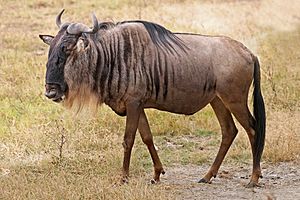 |
|
| C. t. albojubatus In the Ngorongoro Crater, Tanzania |
|
| Conservation status | |
| Scientific classification | |
| Genus: |
Connochaetes
|
| Species: |
taurinus
|
| Subspecies | |
|
C. t. albojubatus (Thomas, 1912) |
|
 |
|
| Distribution of the subspecies:
C. t. taurinus C. t. cooksoni C. t. johnstoni C. t. albojubatus C. t. mearnsi
|
|
The blue wildebeest (Connochaetes taurinus), also known as the common wildebeest or gnu, is a large antelope. It is one of two types of wildebeest. These animals are part of the Bovidae family, which includes cattle and goats. Blue wildebeest have broad shoulders and a strong, heavy front body. They also have a unique, sturdy muzzle.
When they are born, young blue wildebeest are light brown. They start to get their adult colors around two months old. Adult wildebeest can be deep bluish-gray, light gray, or even grayish-brown. Both male and female wildebeest have a pair of large, curved horns.
Blue wildebeest are herbivores, meaning they eat plants, mainly short grasses. They live in large groups and are very fast runners. They are also extremely careful and alert. The mating season starts after the rainy season. A single calf is usually born after about 8.5 months. The calf stays with its mother for about 8 months. After that, it joins a group of young wildebeest.
You can find blue wildebeest in the short-grass plains of southern and eastern Africa. These plains are often next to savannas with acacia bushes. They do best in places that are not too wet or too dry. Some groups of blue wildebeest travel long distances. This migration happens every year. It matches the rainfall and grass growth. This way, they can find the best food for mothers and their calves.
Blue wildebeest live naturally in Angola, Botswana, Eswatini, Kenya, Mozambique, South Africa, Tanzania, Zambia, and Zimbabwe. They are no longer found in Malawi, but they have been successfully brought back to Namibia. The southern border of their home is the Orange River. The western border is near Lake Victoria and Mount Kenya. Blue wildebeest are common and are being introduced to many private game farms and nature reserves. Because of this, the International Union for Conservation of Nature and Natural Resources says they are of least concern. This means they are not currently in danger of disappearing. There are about 1.5 million blue wildebeest, and their numbers are stable.
Contents
What is a Blue Wildebeest?
The blue wildebeest was first described in 1823 by a scientist named William John Burchell. He gave it the scientific name Connochaetes taurinus. It belongs to the same group, or genus, as the black wildebeest. Both are part of the Bovidae family, which includes animals like cows and goats.
The name Connochaetes comes from Greek words. These words mean "beard" and "flowing hair" or "mane." The name taurinus means "bull." The common name "blue wildebeest" comes from the shiny, bluish-gray color of its fur. The other common name, "gnu," comes from the Khoikhoi people. They are a native group from southwestern Africa who used this name for the animal.
Scientists have studied the blue and black wildebeest. They found that these two species are closely related. They separated into different species about a million years ago.
Types of Blue Wildebeest
There are five different types, or subspecies, of blue wildebeest:
- C. t. taurinus: This is the most common type. It lives in southern Africa, including Namibia, South Africa, and parts of Mozambique, Zambia, and Angola.
- C. t. johnstoni: Also called the Nyassaland wildebeest. It lives from Mozambique to east-central Tanzania. It is no longer found in Malawi.
- C. t. albojubatus: This is the eastern white-bearded wildebeest. It lives in the Gregory Rift Valley, from northern Tanzania to central Kenya.
- C. t. mearnsi: This is the western white-bearded wildebeest. It lives in northern Tanzania and southern Kenya, west of the Gregory Rift Valley.
- C. t. cooksoni: This type, Cookson's wildebeest, is only found in the Luangwa Valley in Zambia. Sometimes, it might wander into Malawi.
Wildebeest Hybrids
Sometimes, blue wildebeest and black wildebeest can have babies together. These babies are called hybrids. Normally, these two species do not mix because they live in different places and act differently. But if they are kept in the same area, they might breed. Their offspring can usually have babies of their own.
How Blue Wildebeest Look
Male blue wildebeest are usually bigger and darker than females. An adult blue wildebeest is typically about 170 to 250 centimeters (about 5.5 to 8 feet) long. They stand about 115 to 151 centimeters (about 3.7 to 5 feet) tall. Males weigh between 170 and 410 kilograms (about 375 to 900 pounds). Females weigh 140 to 260 kilograms (about 300 to 570 pounds). They have a long, black tail that is about 60 to 100 centimeters (about 2 to 3 feet) long.
Blue wildebeest can live for about 20 years in zoos. The oldest known wildebeest in a zoo lived for 24.3 years. How long they live in the wild is not fully known.
Blue wildebeest are very efficient at moving. They can travel up to 80 kilometers (about 50 miles) in 5 days without drinking water. This is even when temperatures reach 38 degrees Celsius (100 degrees Fahrenheit).
What Color are They?
Young wildebeest are born light brown. They get their adult colors when they are about two months old. Adult wildebeest can be deep bluish-gray, light gray, or grayish-brown. Their backs and sides are a bit lighter than their bellies. They have dark brown stripes between their neck and ribcage. This is why they are sometimes called "brindled gnu."
Both males and females have long, stiff, thick, black manes. Their tails and faces are also black. Some types of wildebeest have floppy manes, while others have manes that stand straight up. Wildebeest also have Scent glands on their front feet. These glands release a clear oil and are larger in males.
The western white-bearded wildebeest is the smallest type of blue wildebeest by skull length. It is also the darkest. The eastern white-bearded wildebeest is the lightest. The eastern and western white-bearded wildebeest have creamy white beards. Other types, like the Nyassaland wildebeest, have black beards.
Their Horns
Both male and female blue wildebeest have large horns. These horns are shaped like parentheses, curving out to the sides, then up and in. Male horns can be up to 83 centimeters (about 33 inches) long. Female horns are shorter, about 30 to 40 centimeters (about 12 to 16 inches) long. Even though they are antelopes, their horns look a bit like those of an African buffalo. Their strong build also makes them look a bit like cattle.
Life and Behavior
Blue wildebeest are most active in the morning and late afternoon. During the hottest parts of the day, they rest. These animals are very quick and careful. They can run up to 80 kilometers per hour (about 50 miles per hour). When they run, they wave their tails and toss their heads.
Wildebeest usually rest close to each other in groups. Males form groups called bachelor herds. These groups are less active than young wildebeest groups. About 90% of male calves join bachelor herds before the next mating season. Male wildebeest become territorial when they are four or five years old. They become very noisy and active. They can live close to other males, with many bulls in a small area. Most territories are temporary.
Blue wildebeest usually rest in groups at night. These groups can have a few animals or thousands. They keep a small distance from each other, except for mothers and calves. Wildebeest are a main food source for many predators. These include lions, cheetahs, leopards, African wild dogs, hyenas, and Nile crocodiles.
Female calves stay with their mothers and other related females in the herd for their whole lives. During the wet season, females often lead the herd to areas with good grass. They also try to find places where predators are less likely to be. This helps new calves survive and get good milk.
Male wildebeest mark their territories. They use piles of dung, scents from their glands, and certain behaviors. A male defending his territory might stand tall, paw the ground, dig his horns into the dirt, and bellow loudly. When males fight over territory, they grunt, paw the ground, and push with their horns.
What Do Blue Wildebeest Eat?
The blue wildebeest is a herbivore, meaning it eats plants. They mainly eat short grasses that grow in savanna grasslands and plains. Their wide mouths are made for eating a lot of short grass. They eat both during the day and at night. If there isn't much grass, they will also eat leaves from bushes and trees.
Wildebeest often graze with plains zebras. Zebras eat the taller, less nutritious parts of the grass. This leaves the shorter, greener grass that wildebeest prefer. Wildebeest like to drink water twice a day if they can. Because they need water regularly, they usually live in moist grasslands or near water sources. They drink about 9 to 12 liters (about 2.5 to 3 gallons) of water every one to two days. However, they can also live in dry places like the Kalahari desert. There, they get enough water from melons and water-storing roots.
How They Reproduce
Male blue wildebeest are ready to mate around 2 years old. Females can have babies at 16 months if they get enough food. But most females don't start breeding until a year later. The mating season lasts about 3 weeks. It happens at the end of the rainy season. The mating season often starts on the night of a full moon. This suggests that the moon might affect when they breed.
Males compete for females by marking their territories. When they fight, they face each other, bend their knees, and push with their horns. They also make loud noises and dig their horns into the ground. Once a male shows he is dominant, he tries to attract females to his area. A female might visit several territories and mate with different males during the season.
Pregnancy lasts about 8.5 months. Most calves, about 80 to 90%, are born within a 3-week period. Female wildebeest give birth in the middle of the herd, not alone. They usually give birth in the middle of the day. This gives the newborn calf time to stand up and get steady before night. At birth, calves weigh about 19 kilograms (about 42 pounds). They can usually stand within a few minutes. Calves stay close to their mothers to avoid predators. They might keep drinking milk until the next calf is almost due. Male calves leave their mothers at about 8 months old and join groups of other young males. In large female herds, 80% of calves survive the first month. In smaller herds, only about 50% survive.
Health and Illnesses
Blue wildebeest can get diseases like foot-and-mouth disease and anthrax. They can also get skin problems and infections in their hooves. In one drought, young calves and older females were most likely to die. Other times, diseases caused about 47% of deaths, and predators caused 37%. The rest were from accidents.
Wildebeest can also have many different parasites. These include worms, flies, lice, and ticks. Most of these parasites are more common at certain times of the year. Compared to some other animals, blue wildebeest are quite good at resisting tick infestations.
Where Blue Wildebeest Live
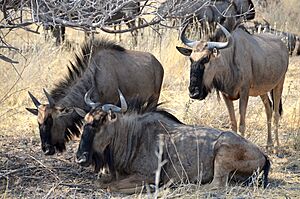
Blue wildebeest live in Kenya, Tanzania, Botswana, Zambia, Zimbabwe, Mozambique, South Africa, Eswatini, and Angola. They are no longer found in Malawi, but they have been brought back to Namibia.
They mostly live in short-grass plains next to acacia bush savannas in southern and eastern Africa. They prefer areas that are not too wet or too dry. They can live in different places, from overgrazed areas with thick bushes to open woodlands. They can handle dry regions as long as there is clean water nearby, usually within 15 to 25 kilometers (about 9 to 15 miles). They are not found in mountains or very cold grasslands. You rarely see them above 1800 to 2100 meters (about 5900 to 6900 feet) high.
Three groups of blue wildebeest in Africa make long migrations. These travels happen at the same time as the yearly rainfall and grass growth. This allows them to find the best food for mothers and their calves. The timing of these migrations can change each year. At the end of the rainy season, they move to drier areas because there is less drinking water. When the rainy season starts again, they travel back to their wet-season homes. These movements help migratory wildebeest populations grow much larger than groups that stay in one place. Many long-distance migrations used to happen 100 years ago. Now, only three major migrations are left: in Serengeti, Tarangire, and Kafue.
Threats and Protecting Them
Human activities are a big threat to wildebeest. These include cutting down large forests, water sources drying up, growing towns, and illegal hunting. Diseases from farm animals, like sleeping sickness, can also spread to wildebeest and harm them. Fences that block their traditional migration paths can cause many wildebeest to die. This happens when they cannot reach water or better grazing areas during dry times.
For example, in the Maasai Mara area, the number of wildebeest dropped by about 80% in 20 years. This was mainly because farming expanded, taking away their grazing lands and breeding areas. Similar big drops have happened in the Tarangire wildebeest migration.
The total number of blue wildebeest is estimated to be around 100,000. Overall, their population is not stable. However, in Serengeti National Park (Tanzania), their numbers have grown to about 1,300,000. Blue wildebeest have also been brought into many private game farms and reserves. Because of these efforts, the International Union for Conservation of Nature lists the blue wildebeest as being of least concern. This means they are not in immediate danger. However, the eastern white-bearded wildebeest (C. t. albojubatus) has seen a big drop in numbers. There are probably only 6,000 to 8,000 left, which is a concern.
Wildebeest and Humans
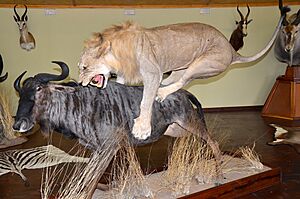
Blue wildebeest are a major reason tourists visit southern and eastern Africa to see big game. This makes them very important for the economy of the region. Historically, people hunted blue wildebeest for their hides and meat. Their skin makes good leather, but their meat is often tough and dry.
However, blue wildebeest can also cause problems for humans. They can compete with farm animals for grass and water. They can also spread serious diseases to cattle, like rinderpest. They can also carry ticks, worms, and other parasites.
An old carved stone slab, dating back to about 3000 BC, was found in Hierakonopolis, Egypt. It shows an animal that looks very much like a blue wildebeest. This might mean that these animals once lived in North Africa and were known to the ancient Egyptians.
Images for kids



